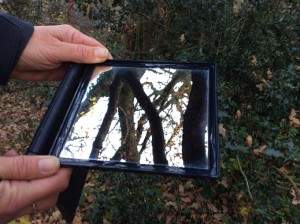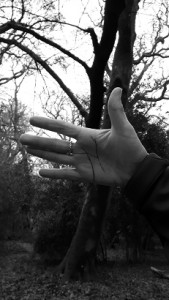
The New Forest’s woodlands become different places in the winter. Leaves fall from deciduous trees, in a myriad of autumn colours, to reveal bare branches and twigs with pointy buds. Suddenly leafless, this is the best time to study the shapes and silhouettes of trees; the ancient oaks look bent and wrinkled whilst silver birch look slender and smooth. Here are some fun ideas to help ID and learn about trees in winter:
- Twiggy friends: Gather in preparation pairs of twigs which match the trees in the area to be explored. Hand out a twig randomly to each person in the group and challenge them to find the friend they are going to be working with by matching their twigs. When they have found their friend, they go together in search of the tree that matches their twigs (activity from Wild Time Learning).
- Mirror imagery: Invite each pair to sit under their tree and to use a mirror to look up into the canopy. Can they see the criss-cross patterns that the twigs make against the sky? Can they imagine being a nimble squirrel climbing and jumping from branch to branch or maybe the upside-down world of a nuthatch, a bird that can climb head-first down tree trunks in search of hidden insects?
- The Great Plant Hunters: Encourage each pair to use their senses to explore their tree. For example, the bark patterns vary a lot with tree species and age. Bark rubbings are a fun way of recording these patterns and textures: smooth, wrinkled, peeling, corky – trees have their own character. If they were explorers finding it for the first time, what name would they give their tree?
- Tree detectives: Using tree field guides and winter twig ID sheets (The Woodland Trust) discover its official name. Twigs, leaf buds, bark and tree shape can help with identification. For example, a beech tree has slender, rather delicate twigs with long, alternate and distinctly pointed brown buds. Look for evidence on the ground for other clues – fallen leaves, seeds or fruits.
- Hand connections: Now leafless, can you match the folds and creases of your hand to the shape of a trees branches and twigs? Draw onto your hand the matching pattern. Everyone’s hand prints are unique – just like a tree’s shape. Maybe this could become your special tree which you can visit to be still for a moment and simply enjoy being in its presence.

- Tree imagery: Stand back to look at the silhouette of your tree. Draw its shape and using similes – comparisons using the words as and like – write short descriptive sentences that that fill the shape to help describe the trees character and features.
- Tree naming celebration: Provide time for each pair to show everyone their tree and to share findings and feelings. Take photographs of your tree. These can be compared to the tree when it awakens in the spring and note the date when the first leaf buds open.
